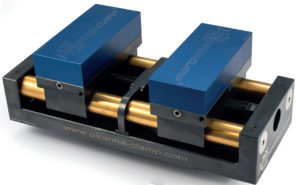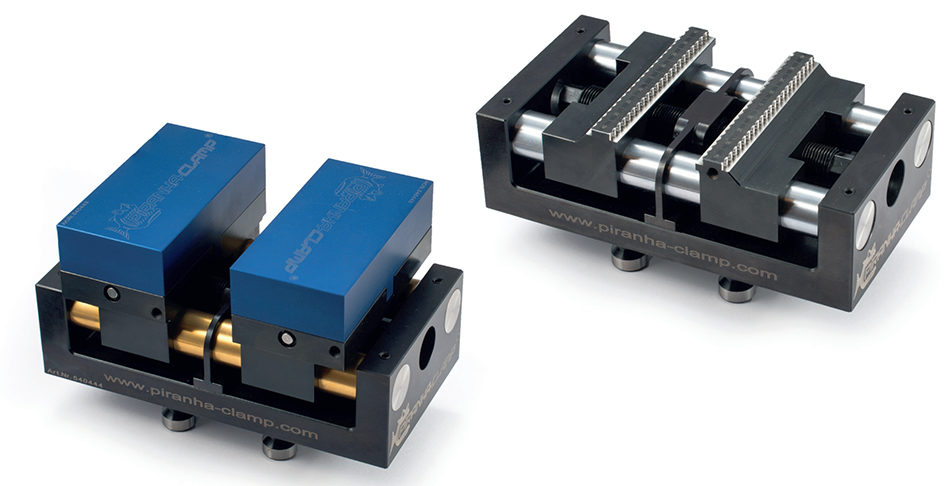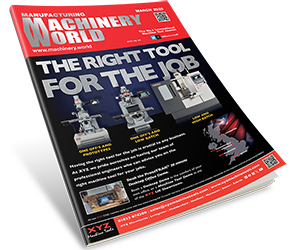Workholding and manufacturing ancillary specialist, Leader Chuck Systems, recently added the Piranha Clamp range of high precision centring vices to its extensive product portfolio. The 100 per cent Swiss manufactured range offers a number of performance advantages for machine shops using prismatic machining techniques.
It is no coincidence that the vice range is called Piranha, named after a fish that has a reputation for a strong bite and, relative to body mass, achieves one of the most forceful bites measured in all vertebrates. In place of the usual dovetail guides found on many vices the Piranha features parallel, twin cylindrical jaw guides that ensure high precision and an unbeatable clamping force. Designed to act much like a hydraulic press, the hardened and specially coated spindle guides provide an increased surface area for load distribution, while the drive spindle has been tested to withstand pressures above 1,300 Nm².
 This capability supports high pressure workpiece clamping with a minimal depth of just 3 mm, so raw material waste is kept to a minimum. The nature of the twin guide design results in an open construction for easy chip evacuation, with any swarf flushed away by the coolant, and an extremely low construction height that makes the most of any machining centre’s working envelope. The very low built-in zero-point clamping system on the base of the Piranha Clamp also provides the optimum interface with the machine tool’s worktable and achieves a repeatable loading accuracy of 0.01 mm as standard. However, the quick-change location system can be specified to fit any existing manufacturers’ zero-point design with adapter plates making the vices totally interchangeable.
This capability supports high pressure workpiece clamping with a minimal depth of just 3 mm, so raw material waste is kept to a minimum. The nature of the twin guide design results in an open construction for easy chip evacuation, with any swarf flushed away by the coolant, and an extremely low construction height that makes the most of any machining centre’s working envelope. The very low built-in zero-point clamping system on the base of the Piranha Clamp also provides the optimum interface with the machine tool’s worktable and achieves a repeatable loading accuracy of 0.01 mm as standard. However, the quick-change location system can be specified to fit any existing manufacturers’ zero-point design with adapter plates making the vices totally interchangeable.
Two base sizes are available, the Piranha Clamp 170 is 170 mm long by 90 mm wide, while the larger Piranha Clamp 300 is 300 mm long by 120 mm wide. The base can be specified with changeable top jaws where a Patented quick-change system for the jaws uses an eccentric ‘cam’ pin to support production efficiencies. Within just a few seconds, a wide range of different standard or pre-machined clamping jaws can be quickly and accurately exchanged. These include aluminium and steel ‘soft’ jaws, that can be machined to profiles that match the workpiece, as well as straight and serrated ‘Snapper’ jaws designed to secure raw billet materials.
Alternatively, the vice can be specified in ‘Snapper’ format, where the base is fitted with serrated jaws as standard. The two rows of teeth on the Snapper jaw face effectively ‘bites’ into the raw material, pulling it down with the bottom row of teeth and providing an extremely secure hold with the upper row for aggressive machining applications. With the Snapper jaws the raw material does not require pre-stamping saving time on every workpiece machined, the initial capital expense of purchasing the necessary hardware to perform the stamping operation and the on-going regular expense of sending the stamping dies back to the vice manufacturer for regrinding.
Managing Director, Mark Jones, says: “Designed for the efficient processing of prismatic components or billet raw material, especially using simultaneous 5-axis machining techniques or aggressive raw material removal toolpaths, the Piranha Clamp range of centring vices with Snapper or changeable jaws can improve the precision and productivity of almost any machine shop. The clamping forces achieved are phenomenal and, as you would expect from a Swiss manufacturer, the quality and precision is class leading. Tested against established vices that use pre-stamped raw material, at the same clamping pressure the deflection measured in the Piranha range is just one-tenth of that measured in the competitor’s vices. This makes the vice more accurate for both first operations and more repeatable for second operation work.”







